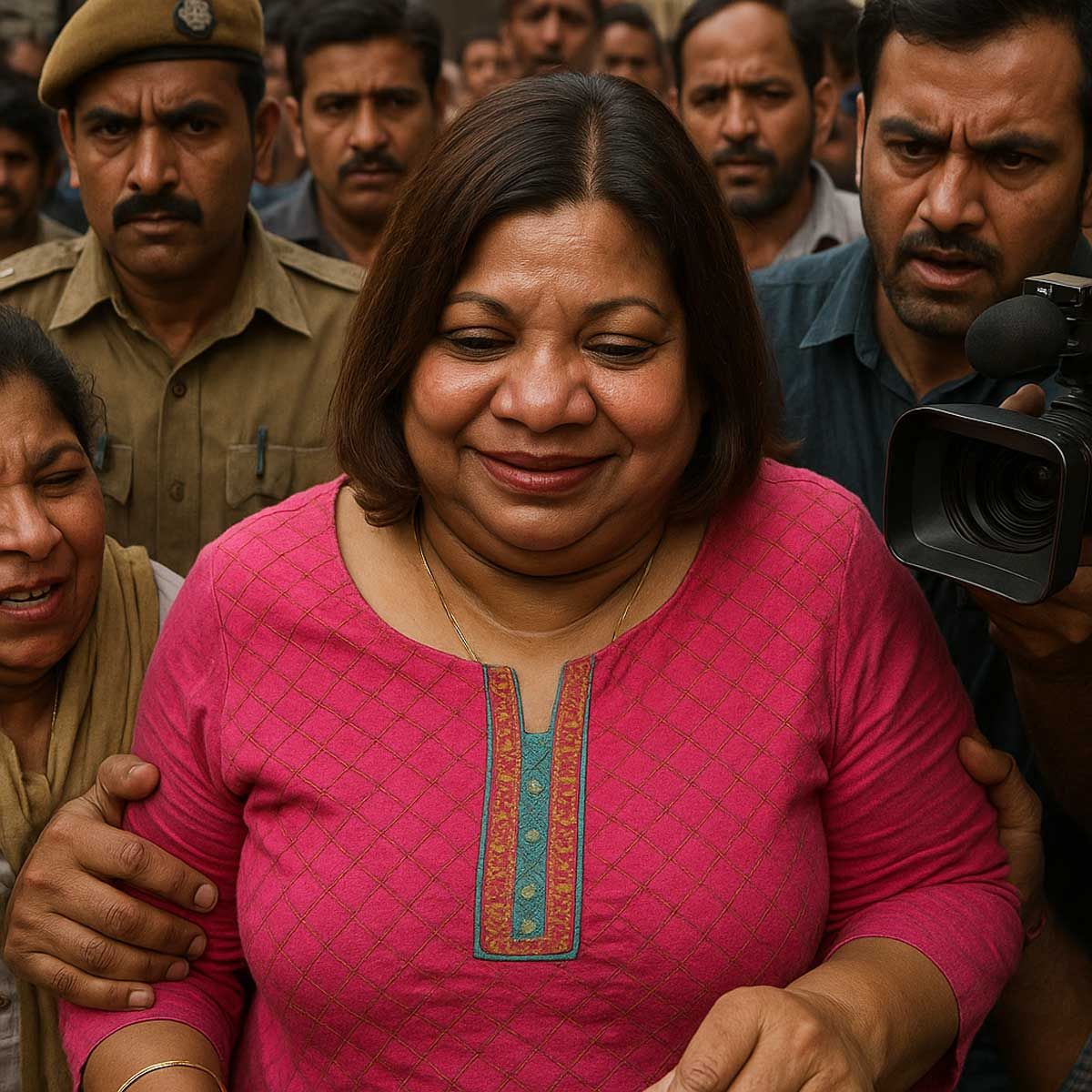More Coverage
Twitter Coverage
Satyaagrah
Written on
Satyaagrah
Written on
Satyaagrah
Written on
Satyaagrah
Written on
Satyaagrah
Written on
JOIN SATYAAGRAH SOCIAL MEDIA
"Bites That Bind: The Rabies Reality": In Meerut, the tragic rabies death of an 11-year-old boy, months after a street dog bite, reveals a harrowing stray dog crisis, underscoring the critical need for immediate and humane animal control measures

In a heart-wrenching incident from Meerut, a young life was lost to the deadly grips of rabies. An 11-year-old boy succumbed to the disease two months after being bitten by a street dog, throwing a spotlight on the city's alarming stray dog problem.
|
The boy, a resident of Surya Palace Colony within the jurisdiction of the Brahmpuri police station, was attacked by a dog on the festival of Rakshabandhan. Despite the severity of the bite, the family did not administer the crucial anti-rabies vaccine, a decision that had fatal consequences.
As per a report by Live Hindustan, the boy, identified as Dushyant, began showing symptoms of rabies. His condition worsened rapidly, leading to a tragic end. "Late on Sunday night (5th November), the child died in agony at home," the report stated, underscoring the harrowing ordeal the child endured. The family, grieving their unimaginable loss, performed his final rites at Brajghat.
This case is not isolated, as Meerut grapples with a stray dog population that exceeds 1 lakh, posing a significant public health challenge. The tragic event is a grave reminder of the importance of immediate medical attention and vaccination following animal bites, and it raises urgent questions about municipal measures to control the stray dog population and prevent such incidents in the future.
In the heart of Meerut, a family mourns the loss of young Dushyant, whose life at just 11 years was cut tragically short by rabies—a fate that strikes a chord of grief and regret, and calls into question the efficacy of local health and municipal protocols.
Dushyant, the son of Dhannu, encountered the peril that roams the streets of the city on Rakshabandhan—a day that should have been filled with celebration, not sorrow. The dog bite that he suffered was met with an initial oversight that proved to be fatal: the crucial anti-rabies injection was not administered in time. It was a delay that turned a curable bite into a death sentence, a mistake that dawned on the family as Dushyant’s condition deteriorated, a realization that came too late.
|
The streets of Meerut, teeming with over one lakh street dogs, narrate a story of administrative shortcomings. The local governance, it seems, has faltered in the realms of birth control and anti-rabies vaccination for these animals. District hospital records indicate the availability of vaccine stocks, yet their administration lags woefully behind needs, underscoring a gap between resources and their effective deployment.
Despite clearances for an animal birth control center, its establishment remains unactualized, a point of contention highlighted in a Jagran report. This inaction not only perpetuates the population surge of strays but also leaves citizens vulnerable to preventable diseases.
The loss of Dushyant is a poignant reminder of the consequences of such lapses. It is a call to action for the municipality to prioritize public health measures, to bridge the chasm between policy and practice, and to safeguard the lives of its citizens—so that no other child suffers a fate similar to that of young Dushyant. The time for that change is now—lest we witness another tragedy borne from preventable causes.
The stark reality of Meerut's battle with rabies is reflected in the harrowing statistics from the district hospital, which records approximately 125 dog bite cases daily. This alarming figure sets the backdrop for the tragic tale of 11-year-old Dushyant, whose fight against the rabies virus came to a grievous end.
 |
In the final days of his struggle, Dushyant's condition worsened despite the desperate efforts of his family. They sought help first at the local district hospital and then in Delhi, only to be met with the heartbreaking news that his condition was beyond recovery. The journey to AIIMS, a beacon of hope for many, also proved futile for Dushyant.
The family's return to Meerut was a journey fraught with anguish, seeking any local treatment that might offer relief. Yet, in the quiet of 2 a.m. on a Sunday night, Dushyant's battle ended. As dawn broke, the family carried out the somber ritual of the last rites at Brajghat, a poignant testament to a life lost too soon.
Dushyant's story is not an isolated one. It echoes a similar incident from Ghaziabad, where a video capturing the final moments of 14-year-old Shahvej went viral, becoming a symbol of the urgent need for effective rabies control measures. His passing, in his father's arms, a month and a half after a dog bite, not only stirred public emotion but also ignited a call to action against this preventable yet fatal disease.
|
Together, these cases underscore a crisis that demands immediate attention—a plea for more robust animal control measures, wider availability of vaccines, and heightened public awareness. The grief that envelops Meerut and beyond serves as a stark reminder of the dire consequences of inaction.
In a silent moment that had far-reaching consequences, a young boy in Meerut failed to inform his family of a dog bite, a crucial lapse that ultimately led to his untimely death. The absence of a timely anti-rabies vaccine, due to the family's unawareness of the incident, allowed the disease to progress unchecked. Tragically, the boy's health declined irreversibly, and he passed away on the 4th of September.
In a stark reminder of the urgency of the situation, just days later, Ghaziabad in Uttar Pradesh reported over 25 cases of dog bites in a single day. Two individuals from this group were deemed to be in critical condition, highlighting the severity of the threat posed by street dogs. In response, the local administration was prompted to issue a public advisory detailing the dos and don'ts following a dog bite incident, aiming to educate the population on immediate and effective response measures.
The gravity of the rabies problem in India is underscored by a chilling statistic: the country accounts for 36% of rabies deaths worldwide. This staggering figure brings to light the dire need for widespread and systematic rabies prevention strategies, including public education, dog vaccination, and population control measures.
|
The sorrowful narrative that unfolded in Meerut is a call to action. It emphasizes the necessity for immediate medical attention following animal bites and reflects the critical role of community awareness in preventing such needless loss of life. As the country grapples with the challenge of rabies, the stories of those lost serve as a somber reminder of the human cost of this ongoing public health issue.
The stark reality of street dog aggression in India has cast a shadow over the safety of its citizens. The menace posed by these animals is not a small-scale issue, as the country hosts an estimated 6.2 crore street dogs. To put this into perspective, for every 100 people in India, there are approximately four street dogs.
The data concerning stray dog bites are staggering, with India reporting nearly 16 million cases from 2019 to 2022, which translates to an average of over 10,000 dog bites every day. This issue is not only about the frequency of bites but also their deadly aftermath. According to a WHO report, rabies claims about 21,000 lives annually in India, with dogs accounting for 99% of the transmission of this fatal virus.
While the situation demands urgent attention towards human safety, it also necessitates a balance with the constitutional and legal provisions concerning animal welfare. Article 51A of the Indian Constitution enshrines it as a fundamental duty of every citizen to exhibit compassion for living creatures. Moreover, The Prevention of Cruelty to Animals Act of 1960 categorizes the infliction of unnecessary pain or suffering upon any animal as a punishable offense.
|
Indian courts have been proactive in addressing this dual concern. They have issued directives aimed at preventing animal cruelty and suffering, while simultaneously urging State Animal Welfare Boards to take decisive steps in aligning with the legal mandate. The challenge lies in executing these directives effectively, in a manner that upholds the dignity of animal life while prioritizing the well-being and safety of people.
Amid the escalating crisis of stray dog aggression in Kerala, the Justice Siri Jagan Committee, appointed by the Supreme Court, underscored the urgency of the situation with a stark declaration: "in view of the very grave situation prevailing in the state of Kerala on account of the stray dog menace, to safeguard the interests of the people of the state and to protect the people from the dangers caused by stray dogs, it is imperative to find some means for the immediate reduction of the stray dog population in the state to a manageable level, on a war footing." This statement places the safety and well-being of Kerala's residents at the forefront, calling for swift action to mitigate the risks posed by an overwhelming stray dog population.
Simultaneously, the courts have maintained that street dogs have an inherent right to life, suggesting that a comprehensive sterilization initiative is key to controlling their proliferation. This perspective emphasizes a humane approach to managing the stray dog problem, aligning with animal welfare principles while also addressing public health concerns.
In a move reflecting the gravity of the situation, the Nagpur bench of the Bombay High Court took a firm stand. On October 20, 2022, the court issued an order: "no citizen and no resident of Nagpur and areas surrounding it shall feed or make any attempt to feed the stray dogs in public places, gardens, etc." This directive followed observations that the street dog issue had intensified "beyond tolerable limits," necessitating decisive legal action to ensure the safety of the populace.
|
In a directive that intertwines public responsibility with animal care, the court ruled that anyone wishing to feed stray dogs must first adopt and register them, effectively taking them off the streets. Furthermore, the court granted authority to Nagpur's police to enforce Section 44 of the Maharashtra Police Act, which allows for the lawful destruction of stray dogs following due procedure, underlining the measures considered necessary for the immediate restoration of public order and safety.
The contentious debate over the management of stray dogs in urban India took a significant turn when the Supreme Court intervened in November 2022. Challenging the order issued by the Nagpur bench of the Bombay High Court, the apex court stated, "Holding that citizens have the right to feed stray dogs, the SC ordered the municipal corporation to identify and demarcate areas where such feeding shall be allowed," while also mandating the corporation to take lawful actions to curb the nuisance created by street dogs.
This ruling is a testament to the Supreme Court's acknowledgment of the rights of citizens to care for stray animals within a framework that also addresses public safety concerns. By directing the demarcation of specific feeding zones, the SC aimed to strike a balance between compassion for animals and the need to maintain order and safety in public spaces.
Despite the constitutional and legal provisions, and the courts' empathetic stance, the real-world consequences of the stray dog menace continue to cast a shadow over India's urban centers. Every neighborhood seems to be grappling with the presence of roaming canine packs whose heightened aggression and territorial battles during nighttime present a serious safety threat. There are alarming reports of stray dogs engaging in violent behavior, from chasing vehicles and attacking other animals to more harrowing acts of aggression against children and adults.
The introduction of organized garbage collection systems in cities, while a step forward for cleanliness and sanitation, inadvertently contributes to this problem. The reduction in accessible waste, previously a food source for these animals, has exacerbated their aggressive behavior, leaving local authorities to confront the challenging task of managing this unintended consequence.
As India's cities continue to confront the challenge posed by stray dogs, a pressing question emerges: Who is responsible for controlling this menace? The complexity of the issue is underscored by the multifaceted roles and perspectives of those involved.
It's become evident that the sterilization program, which aimed to reduce and eventually eliminate the street dog population, has not met its objectives. The reasons are manifold, ranging from the prohibitive costs to a lack of engagement from urban local bodies, which are overwhelmed with numerous other civic duties. As such, the program's ineffectiveness has left communities searching for alternative solutions.
Resident welfare associations, too, face a conundrum. While they are directly impacted by the presence of stray dogs, some residents see these animals as de facto nocturnal guardians, providing a sense of security against potential intruders—albeit at a hidden social cost.
Animal welfare organizations staunchly defend the rights of animals and diligently act against statutory breaches. However, their advocacy often does not extend to addressing the concerns of citizens who face the daily reality of aggressive street dogs. This disconnect highlights a broader societal debate on where to draw the line between animal rights and human safety.
Moreover, there are individuals who, out of compassion, feed these strays, often not recognizing that such actions, while well-intentioned, may inadvertently exacerbate the problem by encouraging the presence of dogs in areas frequented by the public.
With the relentless pace of urbanization, the issue of stray dogs is likely to intensify unless a concerted effort is made by all stakeholders. The risks are especially acute for the most vulnerable members of society—the elderly, children, and those with health issues—who face the greatest danger from dog-related incidents.
The conundrum of managing stray dogs is not unique to India. Many Western nations have established policies that reflect a different ethos in dealing with stray animals. In these countries, dogs are cherished pets, often regarded with the same affection as family members, yet they are seldom seen roaming the streets unattended. When dogs are found without owners, they are taken to shelters with the hope of being adopted. However, there is a somber reality to this system—unadopted dogs are often euthanized to make room for incoming strays.
This approach, while controversial, stems from the notion that streets are not a safe haven for dogs. It is a policy built on the premise that municipal authorities are responsible for providing shelters for stray dogs, with a set period during which these animals can be adopted by those who wish to offer them a home. Should adoption not occur, the policy contends that dogs, particularly those deemed too aggressive or too old, should be humanely euthanized.
Advocates for this policy argue that the costs associated with running such shelters and performing euthanasia may ultimately be lower than those tied to sterilization and anti-rabies programs. More critically, they posit that it presents a more humane alternative to the grim fate stray dogs might encounter on the streets, where they could potentially be subjected to harsh acts of retribution from citizens driven to desperation by fear and concern for their own safety.
The debate is a complex one, with strong arguments on all sides. It touches on the balance between compassion for animals and the protection of human welfare. As India grapples with its own stray dog crisis, these international perspectives offer food for thought on potential policy directions. Yet, any solution will require careful consideration of India's cultural context, public opinion, and the welfare of both humans and animals.
The path forward calls for a pragmatic yet compassionate policy decision that aligns with the social and cultural fabric of India. The ultimate goal is clear: to ensure the safety of citizens while upholding the dignity and welfare of animals.
 Support Us
Support Us
Satyagraha was born from the heart of our land, with an undying aim to unveil the true essence of Bharat. It seeks to illuminate the hidden tales of our valiant freedom fighters and the rich chronicles that haven't yet sung their complete melody in the mainstream.
While platforms like NDTV and 'The Wire' effortlessly garner funds under the banner of safeguarding democracy, we at Satyagraha walk a different path. Our strength and resonance come from you. In this journey to weave a stronger Bharat, every little contribution amplifies our voice. Let's come together, contribute as you can, and champion the true spirit of our nation.
 |  |  |
| ICICI Bank of Satyaagrah | Razorpay Bank of Satyaagrah | PayPal Bank of Satyaagrah - For International Payments |
If all above doesn't work, then try the LINK below:
Please share the article on other platforms
DISCLAIMER: The author is solely responsible for the views expressed in this article. The author carries the responsibility for citing and/or licensing of images utilized within the text. The website also frequently uses non-commercial images for representational purposes only in line with the article. We are not responsible for the authenticity of such images. If some images have a copyright issue, we request the person/entity to contact us at satyaagrahindia@gmail.com and we will take the necessary actions to resolve the issue.
Related Articles
- Petition seeking restoration of 27 Hindu, Jain temples inside Quwwat Ul-Islam mosque at Qutub Minar complex rejected by Delhi court
- "At the helm of a new world narrative": Jaishankar articulates the distinct strides New Bharat has made on the G20 stage, heralding an era of enhanced diplomatic relations & global responsibilities, "It is a different world, different India, different PM"
- "Nak-Kati-Rani": Defying Shah Jahan, Rani Karnavati of Garhwal inflicted unprecedented humiliation on the Mughal army, cutting off their noses; her invincible spirit remain unsung in mainstream history, overshadowing the grand tales of emperors
- How Nehru's Govt helped China in conquering Tibet and let go of it's centuries old friend
- China attacked India just three years after PM Nehru reduced the defence expenditure by Rs 25 crores: Union Budget 1959
- Chinese authorities tortured and arrested Tibet Monks for ‘leaking info’ after forcing them to watch the demolition of 99 foot tall Buddha in Draggo county, Kham, Tibet
- How new political ensemble of 'farmer' groups is one of the best news in recent times
- "Spirit of truth and the spirit of freedom-they are the pillars of society": Social media today has become a powerful medium for exchange of views, expressing opinions and thus has become important pillars on which our democracy stands: Bombay High Court
- “When you see a good move, look for a better one as strategy requires thought, tactics require observation”: Analysis of biggest crackdown on terror outfits, ban on PFI fronts, and why Krishna left Jarasandha alive after killing Kansa in Mahabharata
- Supreme Court allows same Muslim brothers to rent temple properties who have wrecked mayhem in Srisailam temple
- Order of banning loudspeaker in hawanshala is taken back by Ambaji Mandir administration: Gujarat
- Woman alleging that SP leader has Rajol Singh kidnapped her daughter, tries to immolate herself in front of Akhilesh Yadav’s car: SP chief ignores her suicide attempt and drives away
- Hindus saved Sikh Gurus, provided weapons training and donated for Gurudwaras: Shattering the Hindu Vs Sikh narrative
- Hindus chanted Ramcharitmanas outside Christian school that had held derogatory Ramleela: Haryana
- Kartar Singh Sarabha - The Freedom fighter who was Hanged at the age of 19 and inspired Bhagat Singh




























